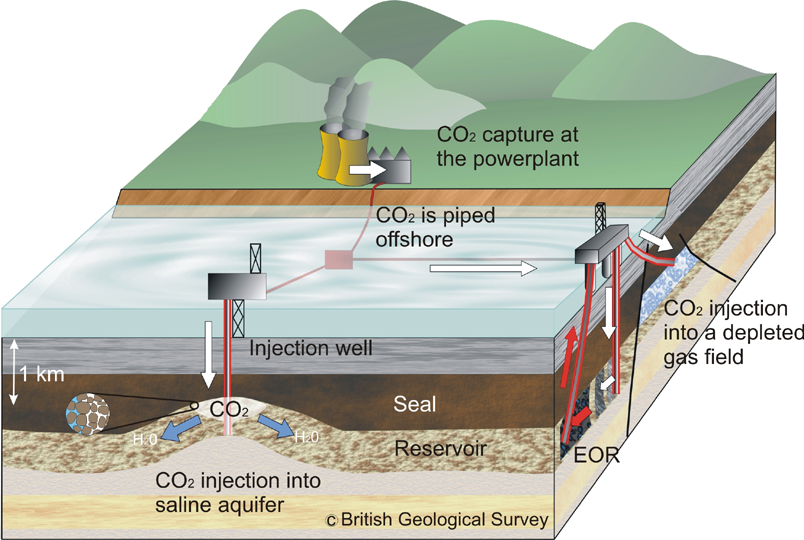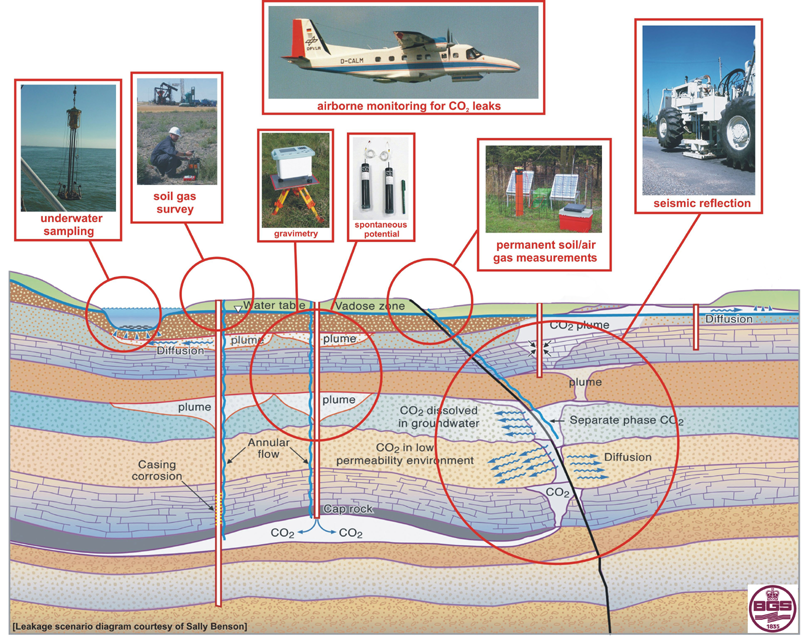Introduction
What is the geological storage of CO2?
Geological storage of carbon dioxide (CO2) is a promising technology for the reduction of greenhouse gas emissions that may complement other options, such as improved energy efficiencies and increased use of renewable energy sources. It involves injection of industrial quantities of CO2 into underground storage reservoirs. Storage is currently being demonstrated in both saline aquifers and also in depleted oil reservoirs. The indications are that geological storage could make a significant impact on our greenhouse gas emissions, acting as a bridging technology to ease the transition from the current reliance on fossil fuels to a low or zero carbon energy system in the future. If CO2 storage is to make a significant contribution to reducing emissions, it will have to be carried out on a very large scale, safely and economically.
CO2 injected into the pore‐spaces of a reservoir rock, via one or more wells, permeates the rock, and displaces some of the fluid (usually saline water or hydrocarbons) that was originally in the pore spaces. The injected CO2 is buoyant and migrates towards the top of the reservoir until it reaches a caprock that prevents its further vertical migration. Permeability barriers such as faults may cause an increase in pressure in the pore spaces, especially around the injection well, which may limit both the amount of CO2 that can be injected into a rock and the rate at which it can be injected. This could make faulted, lower permeability reservoirs unsuitable for CO2 injection.
For more information see: What is CCS? at www.ieaghg.org.

The geological storage of CO2.
Why do we need to monitor storage sites?
To provide assurance that suitable sites can be operated safely and effectively, stored CO2 will need to be monitored. Monitoring aims are twofold: to provide confidence in predictions of the long‐term fate of CO2 in the subsurface and to identify and measure any potentially hazardous leaks at the surface. A diverse portfolio of tools is available for monitoring CO2 storage sites. Many of these are well established and proven in other geological applications, some have been demonstrated as viable in CO2 demonstration projects, while other potentially useful techniques require further research and development.

Monitoring CO2 storage.
What does the Monitoring Selection Tool do?
The Monitoring Selection Tool ranks monitoring techniques in terms of their suitability and applicability to certain user-specified aims and scenarios [ more ].
References
These recent studies provide discussion on the rationale for storage site monitoring and detailed descriptions of various monitoring techniques:
Best Practices for Monitoring, Verification, and Accounting of CO2 Stored in Deep Geologic Formations 2012 Update. Second edition. The Energy lab, National Energy Technology Laboratory. DOE/NETL‐2012/1568.
Benson, S.M., Gasperikova, E. and Hoversten. M. 2004. Overview of monitoring techniques and protocols for geologic storage projects. IEAGHG Report No. PH4/29 89 pages link to IEAGHG Technical Reports